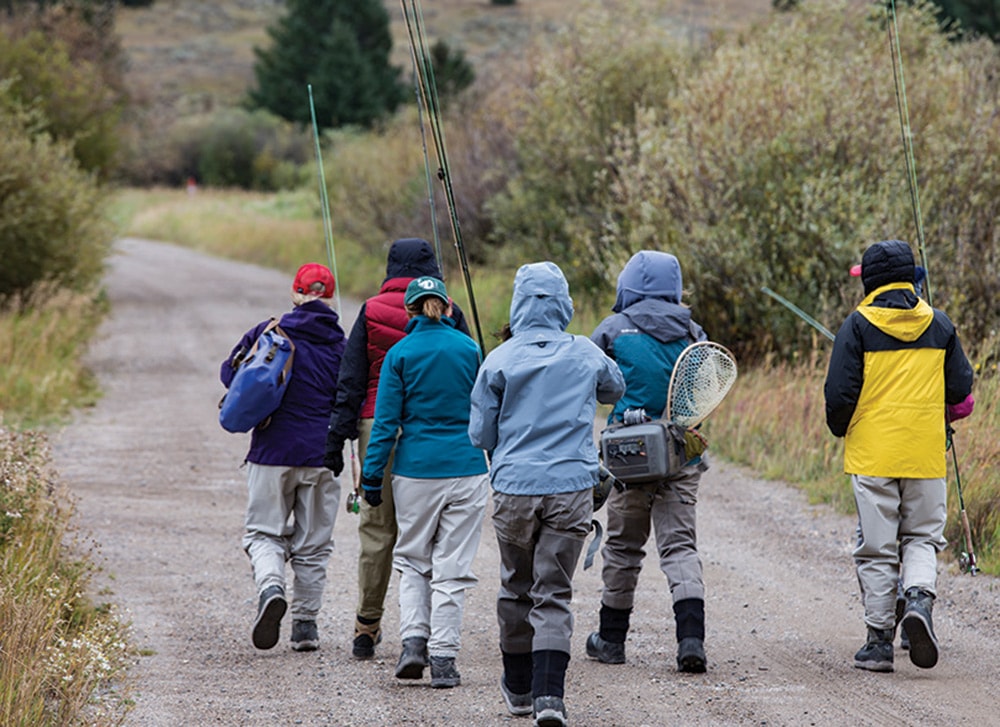
08 Feb Searching for the Spark
BACK IN MY EARLY 20s, when I was living in Big Sky, Montana, I dabbled in fly fishing. I knew enough to tie on flies (albeit slowly) and catch small (tiny) trout on the West Fork of the Gallatin River. Every time I did, I’d squeal with joy, and then quickly feel pangs of both guilt and disgust. I felt guilty for ripping this little fellow from his groove, and I was grossed out at having to actually touch him.
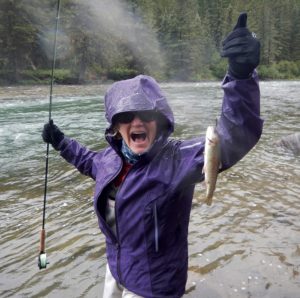
The author excitedly catches her first fish — just before being coached on how to hold a trout for the camera.
One day, a friend offered to take me to his favorite spot on the Gallatin. He set me up behind a rock where I could cast into a nice pool, while he moved further upstream. I fished. And fished. And fished. It felt like I’d been fishing for half the day when he finally came back.
“Well, that was fun,” I said. “What should we do now?”
“It hasn’t even been an hour,” he said. “We’re just going to move up here and fish this other spot. Then I’ll take you to some of my other favorites.”
Fish all day? Yeah, no. I’d been fishing for less than an hour and I was bored out of my mind. Ready to go for a hike, a bike ride, or even just to a bar. Clearly fishing was not for me.
Over the years, I’ve had many angler friends; almost all of them have been male, and many of them completely obsessed. They either do it for a living or head to the river as soon as they’re off work. Date an angler and you either have to start fishing just to hang out with him or never hang out with him at all. And the fishing stories … ugh.
But I have to admit that, deep down, I did kind of get it. Or at least I wanted to. Fishing looked peaceful, graceful even. If so many were obsessed with it, if people flocked to Montana for it, there had to be something to it. I just hadn’t found it myself.
So I went looking.
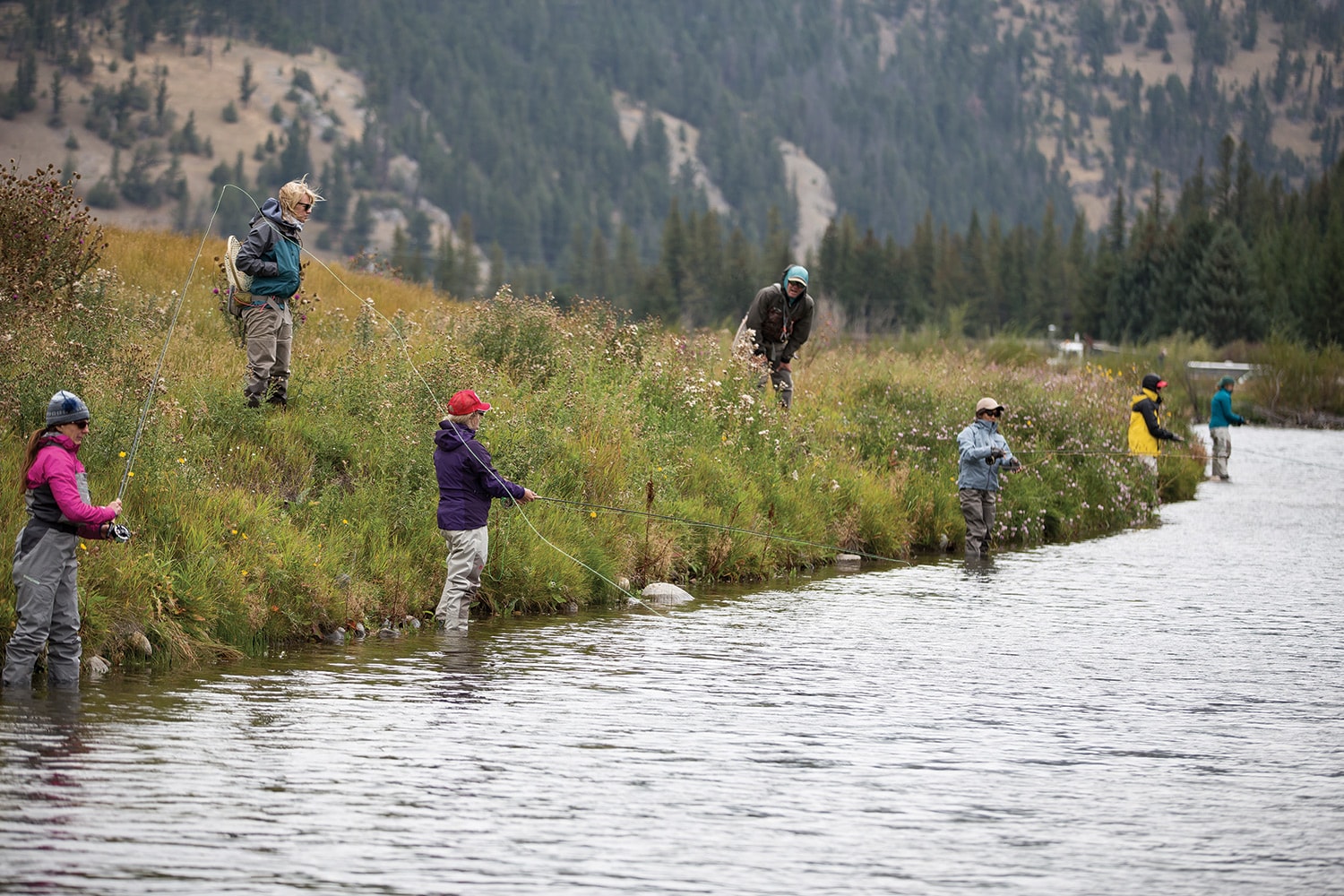 Kara Tripp critiques casting technique from the bank.
Kara Tripp critiques casting technique from the bank.
Twenty years after hanging up my waders, I signed on for a three-day women’s fly-fishing school through Gallatin River Guides in Big Sky. I was taking this course with a set goal in mind: I would be wide-open to the experience to see if I could find that spark, the passion that pushes die-hard anglers.
When I scanned through the itinerary, I tightened up as I read about how long we would be fishing each day. Knot workshops? Yawn. A PowerPoint on entomology? Double yawn. But it looked like we’d be fishing for two days straight. Then I looked at the late-fall weather report. Sandwiched between hot, sun-filled days was a three-day stint of 30-degree temperatures and snow. It was as if all of those years making fun of fly fishing were coming back to haunt me.
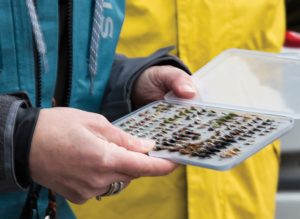
A good fly box will contain a number of possible options.
On a soggy, dark, cold morning, I drove to Big Sky to meet my fellow students. There were five other women, ages 35 and up, from various locales. A woman named Kara Tripp was our teacher.
We went around and explained why we were here. Almost all of the students agreed that they wanted to learn to be independent anglers, that they didn’t want to be led by boyfriends and husbands, having others tie on their flies and tell them where to fish. Instead, they wanted to be empowered to do so themselves.
“Yeah, me too,” I thought.
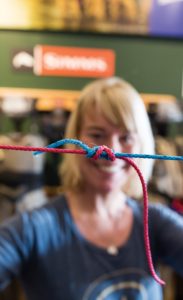
Ropes in different colors, as shown by Kara Tripp, help with knot-tying demonstrations.
Fly fishing has always felt, to me, like a male-dominated sport. According to the 2017 Outdoor Foundation’s Special Report on Fishing and Boating, 35.1 percent of anglers are female. And a December 2017 article in The New York Times claims that “women have become the fastest growing demographic in the sport of fly fishing.” Not too shabby — but I wondered how many were doing it independently versus to appease a boyfriend or husband.
I asked Tripp how her male clients react when she — a woman — shows up to guide them. “I think I just hold my own,” she said. “They might feel disappointed at first, but once they see that I know what I’m doing and where I’m taking them, and they start catching fish, they’re fine. And a lot of them hire me again each time they come out.”
Right away, Tripp’s fishing talent was evident. She had an air of confidence, and deep knowledge of flies, gear, locations, and most importantly, how to catch fish. She had just guided a trip in Russia, and had recently launched Damsel Fly Fishing, a website featuring custom apparel, guided trips, and links to educational classes, retreats, and videos for female anglers. I explained my mission, and she laughed. “You don’t have to love it like I do,” she said, “but it might choose you. You might find the passion.”
We’d see about that.
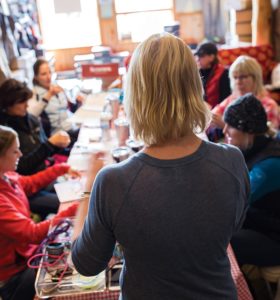
The classroom time was spent around a Gallatin River Guides table in Big Sky.
Day one was classroom-heavy. Tripp brought out large ropes to demonstrate knots. We were all a bit frustrated; what loop goes behind what? This was clearly something that would require a lot of practice. Tripp gave us a slide show to illustrate the different kinds of flies and nymphs, then we matched them with the ones she had laid out on the table. Then she gave a presentation about reading the water, how to analyze where the fish might be hanging out and why.
With a break in the weather, we headed out for some casting on a nearby pond. Tripp taught us the roll cast, a handy one for novices who are more likely to hook the bushes than a fish. Stiff armed, I jerked the fly around. Then Tripp came up behind me, took my arm, and gave it a subtle flick that made the line reach out perfectly toward the water. I clearly was overthinking it.
Tripp walked us through how to set a hook and reel a fish in, while having another guide grab my line, pretending to be a fish. “Set!” she yelled as I yanked the rod back. He ran away from me, and she instructed me to give him more line. He zig-zagged around until coming back as I reeled him in. Each of us took a turn.
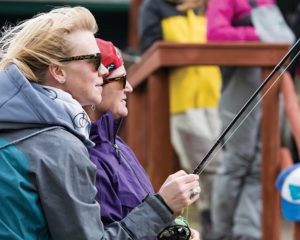
Tripp helps with a cast.
The next day, we split into two groups and hit the Gallatin for a walk-wade mission, snow be damned. It was cold, yes; but so peaceful with the snow clinging to branches and dusting the rocks. I concentrated, trying to nail my roll cast and land it in a small pool, stopping here and there to see how the other women were faring. Tripp coached me on my cast, reminding me of the quick-flick motion. When my indicator moved, she yelled for me to set. Right as my hands went almost completely numb, I watched my indicator dip. I set the hook, and felt weight on the line. I spazzed out trying to reel it in. “Nice one!” Tripp said as she netted it and helped take the hook out. She was being generous. Though it was a tiny rainbow, the adrenaline rush was anything but.
That little fish gave me just enough encouragement to feel somewhat stoked about spending the entire next day fishing the upper Madison River in the snow. We split into two groups, and mine went with seasoned guide Mike Donaldson. We hiked along the river, chatting. By this time, a certain camaraderie was building within the group. Patty from Missoula, who was about 10 years my senior, was an encouraging river companion, and she regaled me with stories about her other outdoor pursuits. I’d watched her gleefully catch a couple of fish the day before, and she had cheered me on as well. Donaldson set us up with double-nymph rigs, and spread us out. Not long after we’d started, Patty let out a yelp and struggled to reel in a fish. I waded toward her with my camera to document her success. Back at my own hole, I started to feel the obsession kick in. I was going to catch a goddamned fish here. I wasn’t leaving this one spot until I did.
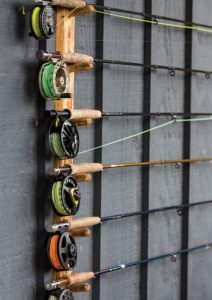
Gallatin River Guides provides gear for those who need it.
By this time, my cast was starting to feel more natural; I was able to think less about that and more about where a fish might be. Watching my indicator, I yanked my line back each time it made a small dip. Donaldson said it typically takes 30 tries at a set until you catch one. I was probably around 45 when I yanked my rod back and felt a heavy weight at the end of my line. Wham. Caught one. A big one by the feel of it. Panicked, I looked over at Donaldson who was standing with Patty. “Ummm, Mike!” While he was calmly walking over, calling out instructions, I was excitedly jerking the rod around like I had Moby Dick on the other end. “Let some line out! OK, reel it in,” he said netting it for me. I posed proudly for a photo, panting from the struggle and thrill, looking at this big, beautiful fish with awe. No guilt, no disgust. More of an adrenaline rush.
I watched Patty catch another couple fish with obvious excitement and the same panic that I’d had. I wondered if that would ever go away. What if I was fishing alone, no Mike or Kara? Would I ever feel confident?
After lunch, we moved to another spot. I felt the same obsession. It was so beautiful with the snow-covered mountains hovering in the background. It was hard to think about much more than the cast, float, and retrieve. Meditative. I liked it. And I caught another fish.
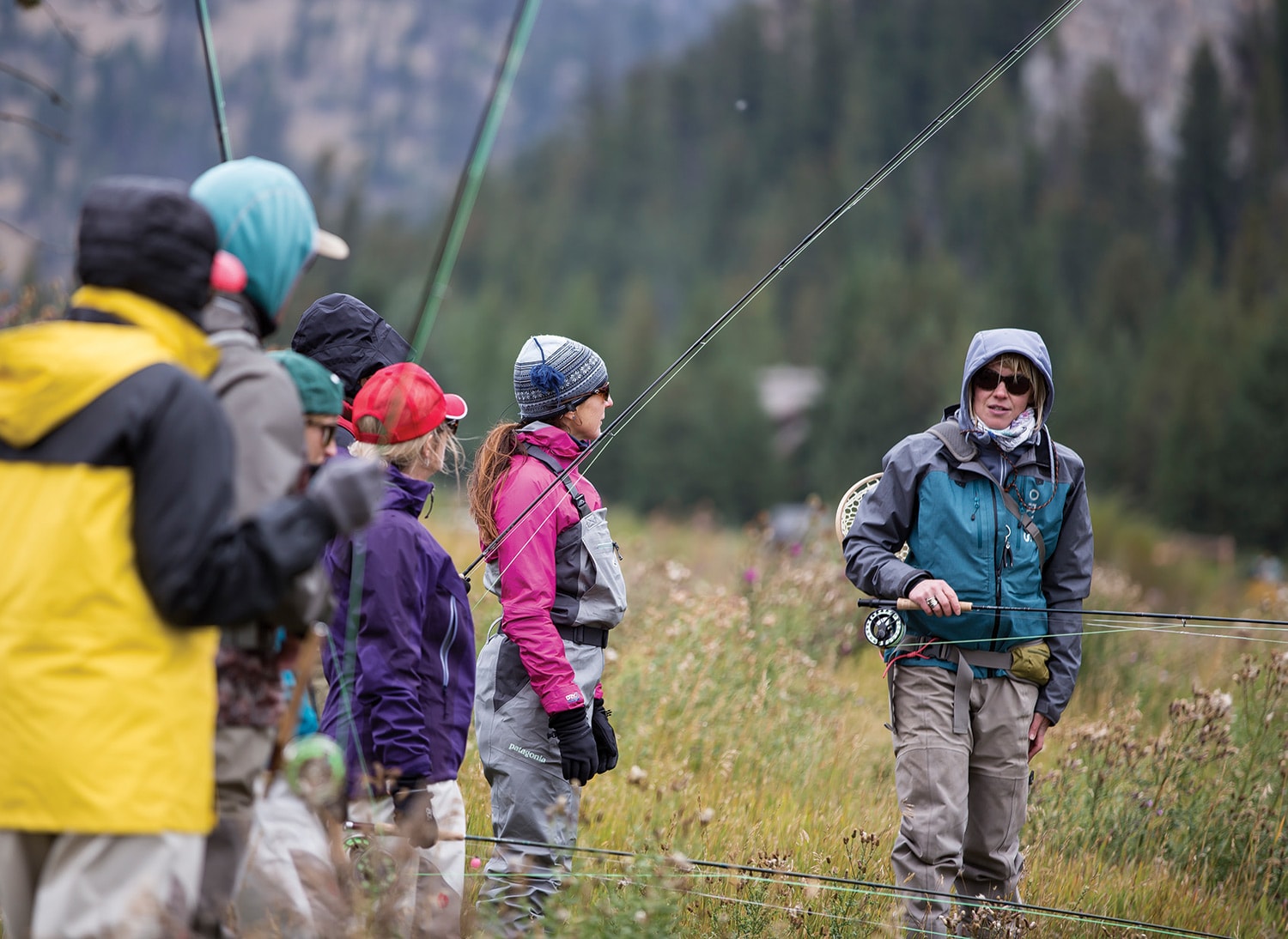 Tripp walks the women through some basics on day one.
Tripp walks the women through some basics on day one.
Pat Straub, owner of Gallatin River Guides, said he started the school five years ago simply because he wanted to give more people the opportunity to get out on the river. “I grew up fly fishing, and I enjoy it for a lot of reasons,” he said. “It’s such a great way to really connect with other people while you’re doing something active in a beautiful place. We wanted something that was all about learning and providing the opportunity for women to meet other female anglers so they can fish on their own.”
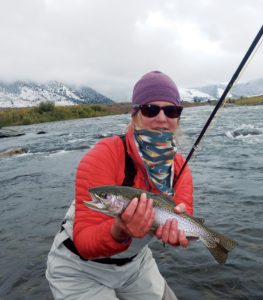
The author, still learning how to properly hold a trout, catches a rainbow on the upper Madison.
After the class, I bought new waders and an updated rod, determined to get out on the river again before winter. And I did. I went once with a woman I met through the class, and she even caught a fish (while I caught a bush). And I went once alone and thoroughly enjoyed the peaceful river time, feeling myself slip away, thinking about nothing more than where a fish might be and how I could catch it.
I have every intention of fishing next summer, hopefully in the company of other women who, like me, are excited to do this on their own. “There’re a lot of people out there who really want to go fishing, but they’re not sure what the next steps are,” Straub said. “You just have to go out and do it, and this fishing school is a nudge in the right direction.”
There might not be a grand epiphany here. I’m 20 years older than I was when I first fished, and my life is much more hectic. So perhaps, through fly fishing, it’s the escape that I’m after, the meditative qualities of rushing water and epic scenery, the game of catching something wild, and having a purpose to be out there. All this appeals to me more than it did in my early 20s. I have more of a need for it in my life now. I’m not saying I will become obsessed with it. But I will keep fishing, and I think I’ll get a lot out of it.
I guess this means I can’t make fun of it anymore.




No Comments